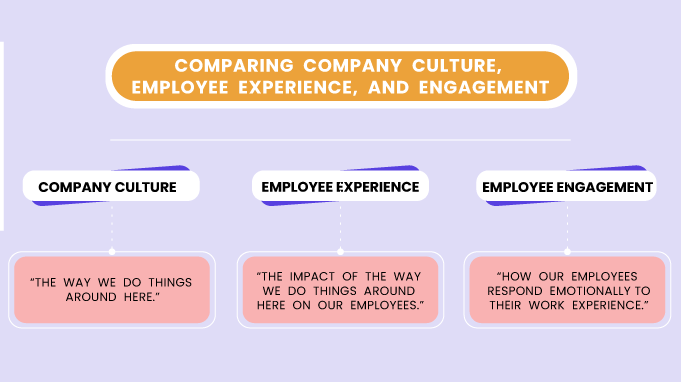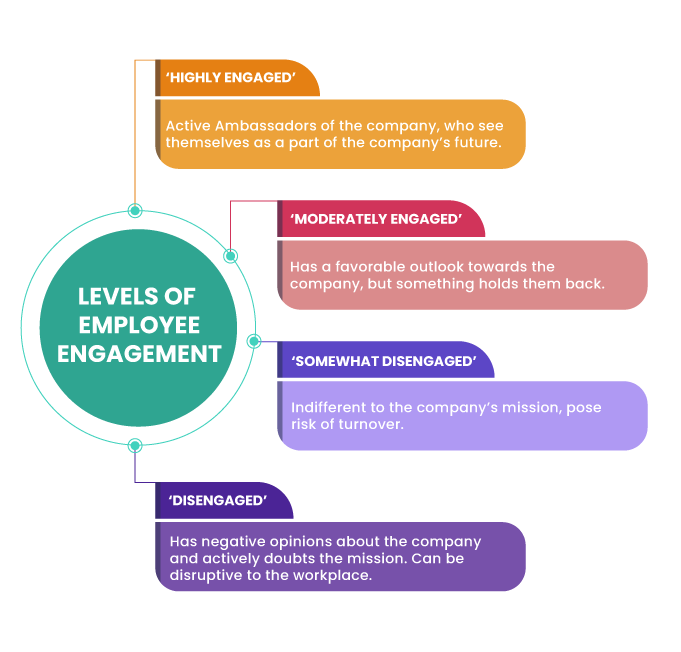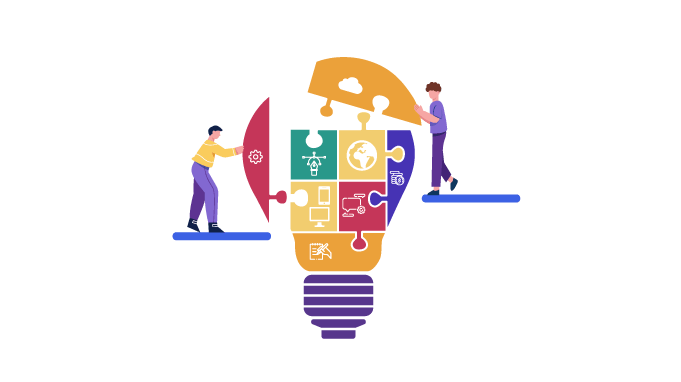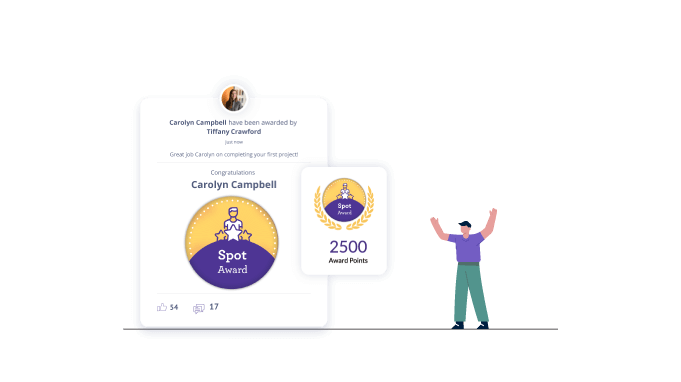Employee Engagement: Creating A Engaging Work Culture
Global statistics on employee engagement are quite grim.
In the US, only about 35% of employees are engaged in their jobs. This percentage drops to 15% if you consider the metrics worldwide. Millennials show a higher tendency to be 'distracted' and 'disengaged' at work.
Thus, the need for an effective employee engagement strategy is only becoming higher.
So, how do you make sure your employees are fully engaged at work?
This article will help you clear all your doubts. You'll get all the basics you need to build up not just a happy workforce but also a strong and engaged team.
Let’s get started.
What Is Employee Engagement?

Employee engagement is defined as an employee's emotional commitment to work and the workplace. It's often mixed up with happiness or satisfaction. But it goes beyond whether or not an individual enjoys their work.
An engaged employee is fully invested in their work. They believe in taking initiative. So they put in discretionary efforts to produce extraordinary results.
Engaged workers don’t work just for a paycheck or a promotion. They actually care about their work, their peers, and the company. Throughout the day, they receive a sense of fulfillment from their job. This eagerness reflects on their individual and company’s growth.
Read more: Download Now: A step-by-step Guide to Employee Engagement
Employee Engagement, thus, is about the following:
- How committed are the employees to their work and workplace?
- How well are the employees communicating and connecting with each other?
But while we understand what employee engagement is, it is also vital to clarify what it is not.
What Employee Engagement is Not
A lot of companies heavily invest in their employee experience initiatives and benefits. Still, they fail to get some of the basics right. There is a misconception that talented people are only drawn to companies with great benefits. Research shows most people are looking for meaningful work, values, and impact-led companies and to work with people from whom they can grow and learn. Clear career pathways and talent succession are just as important as great employee perks.
~ Natalie Firth, Envato's Global People Experience and CSR Director
Employee engagement has become synonymous with terms like employee satisfaction and employee experience. But there are clear differences. Let’s clarify.
Employee engagement is not employee happiness.
Your employees seem happy at work. They don’t seem to have any complaints. But does it mean that they are engaged?
Your employees liking their job doesn't necessarily mean they are emotionally connected to their work.
Happiness is a state of mind. It can stem from simple things like a pleasant morning or a good conversation at work. We cannot deny that such factors are beneficial. But keeping employees engaged is different from making them happy.
Employee engagement is not employee satisfaction.
Although satisfaction is essential, it is only a part of the engagement process. Satisfaction is about enjoying the work irrespective of whether you like the company.
Here is an illustration that’ll help you know the difference:

A satisfied employee may have been working for you for a long while. But they may not feel inspired to go above and beyond their basic responsibilities. But an engaged employee is committed to your success. They are proactive, innovative, and eager to suggest improvements to boost business results.
Employee engagement is not the same as employee experience or culture.
Employee engagement, employee experience, and company culture are all related but distinct terms.
The following infographic will help you understand these HR terms.

Thus, employee engagement is the outcome of a good employee experience. A good employee experience is in turn an outcome of good company culture.
Levels of Employee Engagement

Employee engagement reflects how employees feel about their company. How they feel about work can differ from person to person.
Based on their perceptions, we can categorize employee engagement into four levels.
Highly Engaged
They are innovative, passionate, and have a deep connection with what they do. They are problem-solvers who also motivate others. Highly engaged employees intend to stay for the long term.
Moderately Engaged
Although they spend a good day at work, they are unlikely to ask for new responsibilities. They usually underperform. There are opportunities for improvement in their engagement.
Somewhat Disengaged
This set of employees are not connected to their work and lack motivation. There are high chances that they are looking for other jobs.
Disengaged
They actively doubt the mission and often make their dissatisfaction clear. It is important to take appropriate measures to tackle disengaged employees. Otherwise, they will impact the productivity of all the employees around them.
Now, talking about action, who should be responsible for employee engagement in an organization?
In cultivating a thriving workplace, the responsibility for employee engagement extends beyond a singular role. Rather, it's a collaborative effort involving various stakeholders within the organization.
Here's a breakdown of the roles and responsibilities:
Leadership Team:
Role: Setting the Tone
Responsibilities:
- Establish a positive and inclusive organizational culture.
- Clearly communicate the company's vision, mission, and values.
- Lead by example, demonstrating a commitment to employee well-being.
Managers and Supervisors:
Role: Direct Influence
Responsibilities:
- Foster strong relationships with their teams.
- Provide regular feedback and recognition.
- Address concerns and challenges promptly.
Human Resources (HR) Department:
Role: Strategic Enabler
Responsibilities:
- Design and implement engagement initiatives.
- Conduct regular surveys and assessments to gather employee feedback.
- Develop and execute training programs that align with employee development.
Employees:
Role: Active Participation
Responsibilities:
- Engage in company activities and initiatives.
- Provide constructive feedback.
- Contribute to a positive and collaborative workplace culture.
Cross-Functional Teams:
Role: Collaboration Catalysts
Responsibilities:
- Facilitate communication and collaboration across departments.
- Implement initiatives that promote teamwork and cross-functional relationships.
Internal Communication Team:
Role: Information Dissemination
Responsibilities:
- Ensure transparent communication channels.
- Highlight successes, milestones, and organizational updates.
Wellness and Employee Assistance Program (EAP) Providers:
Role: Supportive Partners
Responsibilities:
- Offer resources for mental health and well-being.
- Implement programs that address work-life balance and stress management.
Why Is Employee Engagement Important?
The importance of keeping your employees engaged for overall business outcomes cannot be overstated.
To understand why employee engagement is important, let’s take note of some statistics:

Engaged workers perform better. They are proactive and go above and beyond what is expected of them. Visionary organizations channel this energy in the right direction to improve performance.
Also, note that employee engagement is contagious. If you are highly engaged in what you do, people are likely to pick up your excitement and join you. But vice versa is also true. If your employee is being disruptive at work, they may negatively impact others. Thus, positive engagement is the key differentiator of growth and innovation.
Here are the benefits of employee engagement:
1. Increased Productivity
Engaged workers are the best performers. They put in discretionary effort to be more productive. Higher employee productivity directly results in positive business outcomes.
2. Higher Retention
High employee retention happens when employees feel connected to their work. They will want to commit more if you recognize their efforts and help them grow.
3. Rise in Profitability
When workers are more productive, the profitability of a company rises. A study shows that companies with engaged employees produce 26% higher revenue. So higher engagement results in an overall increase in the company’s performance.
4. Decrease in Absenteeism
When people don’t come to work, it impacts the productivity of all around them. It delays projects, damages customer satisfaction, and work relationships. But passionate and engaged employees rarely miss their work. They enjoy their work and get it done in the most efficient manner.
5. Enhanced Customer Satisfaction
Employee engagement can directly affect a company’s customer base. When employees are happy, they treat customers well. This results in happy customers. Happy customers are the key to higher revenue and profit generation.
6. Improves Employee Satisfaction
When employees realize how important their work is, they feel good. And no one can deny the importance of employee satisfaction.
Appreciating them every time they do great work lifts their morale. When satisfied workers engage with customers, they spread the same positive vibes. This positively affects your customer experience as well.
Top Strategies To Improve Employee Engagement

Poor employee engagement is a serious concern. Many companies are failing to resolve this problem, which results in high turnover.
The increase in job opportunities increases the chance for employees to switch jobs. Skilled and experienced employees don't mind switching jobs if their efforts go unnoticed.
Who’d like to work at a place where there is no one to appreciate or motivate them? No one.
So you need to focus on fostering a good workplace relationship with the help of effective employee engagement activities. Only then can you retain your top performers.
Below we discuss 14 actionable strategies to increase engagement at work:
1. Start With Onboarding
An employee onboarding process is the best way to get your employees’ attention as soon as they join. Employees get a chance to know the company culture and their colleagues. They develop the initial opinions and thoughts about the company.
So provide them with a smooth onboarding so that they are enthusiastic to start work. You can start with ice-breaking sessions and team-building activities. Also, assign them a mentor to help them around.
2. Ensure A ‘People First’ Culture
A people-first culture is at the center of an engaged working environment. Such a culture is adaptive and puts employees at the center of their priorities. Employees feel like they are an important asset to the company.
To build a people-first culture, you can
- Help your employees be comfortable sharing concerns
- Make sure their voice is heard and respected
- Help them with opportunities for growth
- Provide scope for a fair work-life balance
- Ensure employee well-being
- Use people-centered technology
Employee engagement has an emotional connotation to it. To emotionally connect with your people, start putting them first.
3. Encourage Freedom of Opinions
Employees who feel free to share their opinions and ideas are more productive. You should encourage your employees to express their views more often. Also, conducting regular one-on-one meetings with your workers is a great way to hear them out.
Remember, knowing your workforce will help you drive employee engagement the right way. To do so, pulse surveys are a powerful tool to use.
4. Decentralize Your Power Structure
One of the main drivers of employee engagement is a decentralized power structure. When you give some executive powers to your high-performing employees, they feel valued. It fills them with a sense of responsibility and makes them accountable. This also motivates them to apply new innovative ideas.
5. Involve in Important Tasks
You should also involve employees in the decision-making processes. Employees feel valued when you involve them in the important courses of action. As a result, they work harder for the company's growth.
6. Strong Communication
Communication is the key. Companies with strong communication practices perform better. Lack of communication leads to misunderstandings and pushing of deadlines.
Open communication between the members of the organization is vital. It helps employees open up and discuss ideas or problems they face and builds trust. So try to maintain continuous two-way communication.
To get to know your employees, communicating outside the office is as necessary as inside. Team outings and offsite training programs can help teams bond and coordinate better. Such activities also result in brainstorming sessions. New ideas come up, along with building a better employee experience.
7. Recognize and Reward Efforts

Employees get the utmost satisfaction when they know their worth. They take pride in knowing that their efforts have benefited the company. So, you should make it a point to appreciate your employees and their work. No matter how small their contribution is, always recognize your employees.
Lipika Verma, Vice President - Rewards and Performance Innovation & Thought Leadership at Schneider Electric talks about the importance of the 'whole rewards philosophy': compensation, benefits, development, and environment in our podcast titled "New Age Recognition In The Workplace". She explains how recognition helps people perform better, be motivated, and keep the employee journey going a better way.
To start with recognition, you can go with the classic employee of the month or employee of the year award. Acknowledge their tenure with your company with employee service awards. Promote peer-to-peer recognition and ensure star performers achieve authentic and timely recognition.
Unrecognized contribution hampers both the enthusiasm and passion for working for an organization. Even a simple “Thank you” goes a long way while encouraging and motivating your employees.
Also Read: The Ultimate Guide To Employee Rewards and Recognition
8. Encourage Growth & Development
An employee aspires to learn and grow at his or her workplace. It is a quintessential element that every job seeker looks for in a job. But failing to provide the scope for growth and development leads to dissatisfaction.
Organize training and upskilling sessions for your employees. As a manager, you must always encourage healthy competition within the workplace. Also, reward the best performers for motivating others.
9. Work-Life Balance
All work and no play make Jack a dull boy.
Making your employees work continuously will exhaust them. The issue of employee burnout is real, and you must not overlook it. An employees’ work-life balance is as important as your company’s growth.
When your employees feel enthusiastic about their work, they will give their best. An equilibrium between personal lives and careers will lead to higher engagement.
So try to create a positive work environment that provides a work-life balance. You can include facilities like parental leaves, flexible work, and childcare services. They will help your employees see that you understand your worker’s needs. It will, in turn, boost employees' emotional commitment to work.
10. Ensure Diversity and Inclusion
Diversity in the workplace goes hand in hand with better employee engagement. If your work culture is inclusive, there will be more ideas on the table. Your employees will be more innovative, productive, and engaged.
Gender equality, women empowerment, and women's safety are not just trends or targets. They are the natural way to be. We need to note that almost 40% of the total workforce in the world are women.
So make sure the employee’s lifecycle is diversity-friendly. Start from the recruitment process.
Employees should not face discrimination at work, from the first day till the day they leave. Be it based on gender, region, language, age, or culture. It will inspire the entire workforce to contribute more without any fear of bias.
11. Focus on Coaching Leadership
Top management should devote time and attention to workers. This makes them more accessible to the team. If leaders care, their employees will be engaged. If leaders are disinterested, employees are highly likely to be disengaged.
Leaders are the mentors that employees look up to. For better results, you might need to train the mentors.
As an HR manager, act as the bridge that connects higher management and employees. Interactive sessions, training, and communication can help leaders build better relationships with employees.
12. Prioritize Employee Well-being
A Gallup research has shown that employee engagement and well-being are reciprocal to each other. The future state of one influences the others. But they are also additive in nature. Focusing on employee well-being enhances engagement.
So you cannot ignore employees’ well-being if you want them to engage at work. Focus on both physical and mental wellness to build a more happy and engaged workplace.
Here is what you can do. Ask the right questions at the right time in the right way.
Are they getting proper sleep? Are they drained out? Be very thoughtful and actively listen to them. Provide them professional support and personal freedom.
With remote work, ensuring employee well-being has become more important and challenging. Use technology for fun activities like fitness challenges and diet tracking.
13. Gen Z Friendly Employee Benefits
Millennials employees are going to be 75% of the workforce by 2030. So your old engagement strategies need to be revamped to meet new needs.
Gen Z and millennials are a tech-savvy generation. Also, their priorities are quite different from traditional outlooks. Studies say that 89% of millennials prefer benefits over pay raises. So the benefits you provide them need to be attractive to them.
Work-from-home or a flexible work schedule can motivate them to commit more. Some other options to make your Gen Z workforce happy:
- E-commerce coupons
- Tech support
- Mental health support programs
- Or, even occasionally allowing their pets at work.
14. Measure Employee Engagement
Before you apply these strategies in your workplace, you need to know where you stand. You need to collect data to understand your efforts, the weak areas, and have a benchmark for the future.
Here is where measuring employee engagement comes into play. The following section will give you a detailed idea about measuring engagement.
How Do You Measure Employee Engagement?

Employee engagement can be subjective. It deals with complex factors like commitment, motivation, trust, purpose, and passion.
So the best way to know more about these engagement factors is to ask your employees.
Employee engagement surveys are one of the most effective ways to assess engagement. Surveys help you analyze areas in your workplace that are doing well and where you need to improve. They can be used to compare engagement levels with other organizations.
Below are the types of employee surveys:
Employee Engagement Surveys
These comprehensive surveys can help you understand engagement at the organizational level. They are mostly annual in nature. They measure employee engagement over a longer period of time across several issues.
Pulse Surveys
Pulse surveys help you identify issues right now. They can gather real-time feedback from your new hires and current employees on any topic at any time.
An employee engagement committee could conduct periodic employee pulse surveys to evaluate employee sentiment on various topics such as return to work policy, company culture initiatives, or L&D possibilities.
Also read: 75+ Interesting And Engaging Employee Engagement Committee Names
Employee Lifecycle Surveys
Such surveys collect employee feedback during the key moments in their lifecycle. Exit surveys, new hire surveys fall under this category.
Your overall engagement strategy needs to answer questions like:
- How engaged are your employees right now?
- How engaged will you like them to be in the future?
- How will you identify action areas?
- What measurable outcomes will you use to evaluate progress?
- What specific actions will you take to address the survey results?
- How will you sustain your engagement strategy over time?
Engagement surveys should not just answer if your employees are engaged or not. They also should try to identify why. For that, the survey questions need to be comprehensive and cover a vast range of issues.
Listen to the experiences, and identify what’s important for your employees. You may include open-ended questions that need respondents to elaborate on their points. This will help you develop more meaningful experiences.
Read more: The Right Ways to Measure Employee Engagement Remotely
What Defines An Effective Employee Engagement Tool?

By now, you should have a comprehensive idea of the strategies for better engagement.
But you’ll need tools to execute them.
Employee engagement tools help measure and increase engagement levels in an organization. They help improve the productivity of the employees and reduce turnover.
Here are the features Of An effective Employee Engagement Tool:
Employee Perks
This includes benefits like employee discounts, corporate offers, instant vouchers, gift cards, memberships, and more.
Check out Vantage Perks, A Comprehensive Employee Benefits Program
Employee Recognition
Employee recognition mainly consists of boosting employee motivation. It can be through peer-to-peer recognition, on-spot recognition, or social feed nominations. They also help in rewarding the best performers with awards, badges, and others.
Check out Vantage Rewards, A Complete Employee Rewards and Recognition Program
Employee Pulse Survey
This refers to real-time surveys like Vantage Pulse to measure current engagement level. Features include survey question templates, actionable insights, 360-degree feedback, heatmaps, and others.
Click here to know about Vantage Pulse, A Powerful Employee Survey Tool
Employee Wellness
Employee Wellness tools help create a healthy workforce. They provide features like contests, fitness guides, and personalized goals.
Check out Vantage Fit, An AI Powered Corporate Wellness Solution
Employee Communication
Tools like GoToMeeting and Wrike help maintain the flow of communication. Managers can use these tools to facilitate messaging, file sharing, and collaboration between team members.
Employee Advocacy
Employee Advocacy tools like SproutSocial and LinkedIn Elevate help employees promote their organization through social media.
Conclusion
Employee engagement is all about how you treat and interact with your employees. And only the manager can bridge the gap between employee engagement and disengagement.
There’s no doubt that it’s a tough job. But organizations are adopting many interesting engagement tactics to achieve this.
Having an employee engagement platform can be a brilliant move. AI-powered tools like Vantage Circle are helping HRs boost engagement and wellness. These tools are designed to keep a people-first outlook at the workplace.
Achieving true engagement does not have one simple strategy. It requires a multi-dimensional approach that is fueled by continuous improvement.
In an increasingly volatile world, the future of work is uncertain and dynamic. But one thing is constant. Employees are crucial to a company’s existence.
Doug Conant says, "To win in the marketplace, you must first win in the workplace."
And we firmly believe that success can be achieved only with a truly engaged team.


















